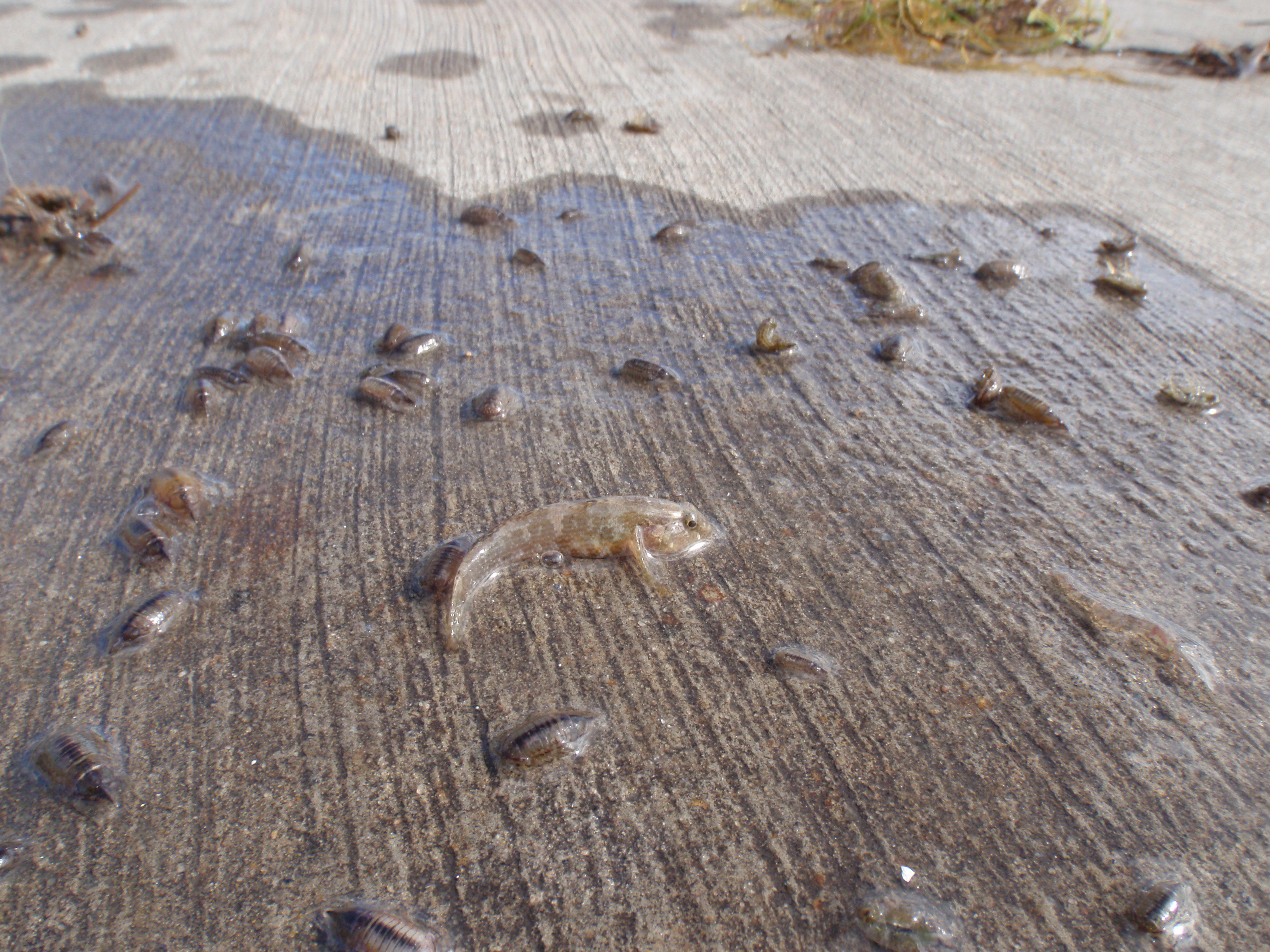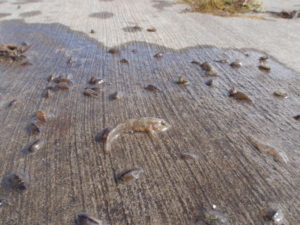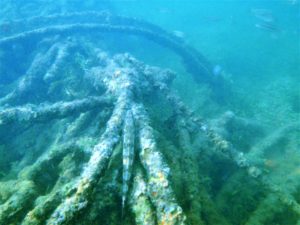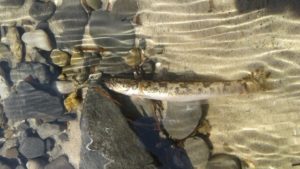I’ve long yearned to have a fish species, or any species at all, named after me. That doesn’t look like happening in a hurry, but I now feel content that I have at least had some influence, no matter how small, on the name of a fish species.
The story behind this ‘naming’ commenced when I photographed this little fish that was found in one of Catherine McMahon’s oyster monitoring baskets at Outer Harbor recently: –
The Krefft’s Frillgoby, Bathygobius krefftii
found at Berth 8, Outer Harbor
(Taken by Steve Reynolds)
I didn’t know what kind of fish it was. I merely considered it to be either a blenny or a goby of some kind. I later posted it online via Bowerbird. Catherine wanted it identified so I also posted in on the iNaturalist Australasian fishes site seeking identification. Sascha Schulz who visited us earlier this year identified it as Krefft’s Frillgoby, Bathygobius kreftii (or ‘krefftii’).
According to the iNaturalist site, Krefft’s Frillgoby “Inhabits shallow seagrass beds & rocky estuaries”. Its environment is said to be “demersal; brackish; marine”. Its distribution is said to be “Indo-West Pacific: New South Wales, southern Queensland and upper Spencer Gulf in South Australia”. Its maximum size is said to be 9.0 cm total length.
I queried the spelling of ‘kreftii/krefftii’ and Sascha’s response was, “As for the missing ‘f’, Steindachner originally called this B kreftii” (with just one ‘f’). (Steindachner name the goby in 1866.)
Mark McGrouther, the Fish Collection Manager at the Australian Museum, said however, “The AFD uses a double ‘f’, as does Eschmeyer”. Mark went on to lodge a taxon change regarding the spelling, reinstating a second ‘f’. The taxon change (taxonomic swap) was posted at https://www.inaturalist.org/taxon_changes/25833 .
Assuming that this taxonomic swap (name change or correction) goes through okay, I like to think that I had some influence on the change.
The only fish book that MLSSA or myself has featuring Krefft’s Frillgoby is “Sea Fishes of Southern Australia” by Barry Hutchins & Roger Swainston. It is species number 564 (on page 98). It is shown in the book as Krefft’s Goby, Bathygobius krefftii (with 2 ‘f’s).
There was also some debate about the distribution of Krefft’s Frillgoby, with Sascha saying that it was a “Trans-located species”. Mark McGrouther’s response was, “I noticed that the AFD shows a disjunct distribution for the species. I don’t have all my refs here at home. Just wondering why you called it trans-located and whether I should add this observation to the outcomes list.”
Sascha’s reply to Mark was, “See Hammer, M.P. 2006. Range extensions for four estuarine gobies (Pisces: Gobiidae) in southern Australia: historically overlooked native taxa or recent arrivals. Transactions of the Royal Society of South Australia 130(2): 187-196. Hammer postulates that the native goby species discovered in Adelaide may have occurred there naturally. I disagree with that on several angles. Firstly, there is suitable habitat along much of the south coast, B krefftii is happy both in seagrass and in rocky areas, and similarly mobile species such as Callogobius are found both in Vic and NSW. B kreffti is a rather large goby species, and is caught in prawn nets, so it should have shown up in records at some stage prior to 2006 if it was always there.”
(Please note the double ‘f’ spelling of ‘krefftii’ above.)
Another photo of the Krefft’s Frillgoby found at Berth 8, Outer Harbor
(Taken by Steve Reynolds)
I had probably never even heard of Krefft’s Frillgoby until earlier this year. That was when I took some photos of a congolli at the Ships’ Graveyard in the North Arm of the Port River. David Muirhead had suggested at the time that the congolli may have been a Krefft’s Frillgoby (see FURTHER DISCOVERIES AT THE SHIP’S GRAVEYARD )
A congolli found at the Ships’ Graveyard
(Taken by Steve Reynolds)
As David recalls, “I/we thought your pics of congolli in Port River or Barker Inlet were Krefts at first. Mark McGrouther’s team proved me wrong on that occasion. My (older but digital and sharp) mlssa PI photo(s) of Kreft’s Frill-goby were, I think, our (certainly my) first encounter, or at least the first time I even heard of or realised what Kreft’s frill-goby was. Maybe we’d, or I’d, seen them before (indeed probably we had, as they are not uncommon in many bays, marinas, etc.. in Gulf St Vincent, also Whyalla area) but I certainly had not known what type of goby they were until then. And that realisation was only within the last 5-8 years, from memory, when I got photos snorkelling at Seacliff just off the Brighton/Seacliff van park, and identified them as Kreft’s from careful scrutiny on PC. Mark McGrouther posted a photo of mine then also, I think. But I don’t think I/we ever wrote any article for MLSSA about my first recognition of Kreft’s ID from when I took the photos. Anyhow, just looking at the photo you sent me via the oyster basket find, I fully agree with Mark and Sascha: that fish is a Krefft’s (sorry for leaving second ‘f’ out till now😊😀). No argument from me on that! (It also somewhat shows how it could be easy to confuse a Congolli with a Krefft”s. But the congolli has a much flatter head and with eyes more widely separated. So nowadays, I can spot the difference with more confidence. Despite saying that, if the fish is seen in hazy seawater, or estuary water so brackish it’s almost as salty, it will still need careful scrutiny, preferably with good photo backup, before anybody could be certain which one it was. And that is partly because they can both occur in similar habitats but also are of similar size, are benthic, and the colours and markings are not much use being similar overall, AND because the congolli can vary greatly in both base colour and markings/patterns/degrees of contrast between dark vs paler spottiness on fins, etc…
PS: If it is found in freshwater with no hint of saltiness, one can rule out Krefft’s more quickly because they don’t survive in pure freshwater e.g. upstream in creeks.”
David himself recently found this congolli dying in a creek at Myponga Beach: –
A congolli found dying in a creek at Myponga Beach
(Taken by David Muirhead)
Details can be found at http://wp.me/p4BvtZ-EA .





